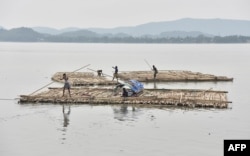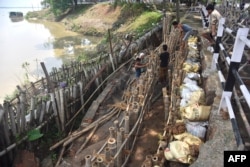Indian government officials said they plan to build a 1,300-km (800-mile) highway along the Brahmaputra River in the northeastern state of Assam to limit damage from annual floods, even as environmentalists said it would be ineffective.
The proposed six-lane highway will cost about 400 billion rupees ($620 million), making it among the most expensive infrastructure projects in the state.
"The Brahmaputra Highway will serve the twin purpose of taming the annual floods and drastically improving connectivity in the region," said Assam Chief Minister Sarbananda Sonowal.
"This is a long-term effort to tame the Brahmaputra as it will be a road-cum-embankment aimed at checking the perennial floods in Assam," he told the Thomson Reuters Foundation.
The state has done a preliminary survey and will submit a report to the transport ministry shortly, he said.
Transport Minister Nitin Gadkari said in New Delhi Wednesday that the project would be fast-tracked.
The 2,900-km Brahmaputra is one of Asia's largest rivers. It runs through Tibet, India and Bangladesh before draining into the Bay of Bengal.
An overflowing Brahmaputra River inundates hundreds of villages and displaces tens of thousands of people every year, while also damaging property and killing livestock and wildlife.
Last year more than 20 rare one-horned rhinos drowned in a national park.
More than 70 people have been killed so far this year, as the state bears the brunt of heavy monsoon rains.
India has the world's highest exposure of gross domestic product to river flooding, with more than $14 billion exposed every year, according to the World Resources Institute.
That could increase more than 10-fold to $154 billion by 2030, WRI estimates.
Embankments are widely used in Assam and elsewhere in the country as a way to contain river flooding.
But breaches are common, causing widespread damage.
"We are yet to build an embankment that does not breach. They are a flawed way to manage floods, as they interfere with the natural flow of rivers," said Dinesh Mishra of Barh Mukti Abhiyaan, a campaign that works with communities in flood-prone areas to manage flooding.
"They restrain the river and therefore increase its intensity, so a breach is inevitable and causes even more devastation, as we have seen any number of times," he said.
The annual flooding of the river is a natural feature that is essential for cultivation when the waters recede. Embankments also interfere with this process, he said.
Mishra and other activists also oppose a planned $50 billion project to interlink rivers to divert water from surplus areas to those that suffer from drought. The environmental impact of the project would be huge, they say.











